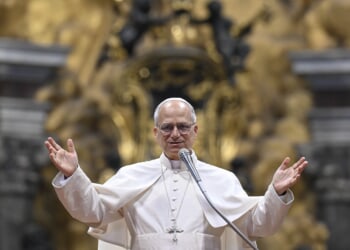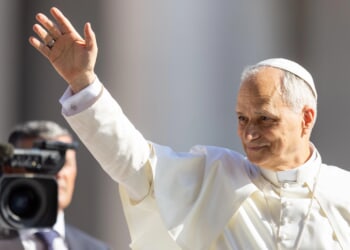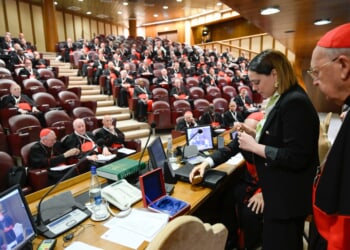Paris, France, May 16, 2025 /
17:11 pm
In 2025, the Church honors a saint whose impact has only grown with time. One hundred years after her canonization, the Jubilee of St. Thérèse of the Child Jesus and the Holy Face — the saint better known around the world as the Little Flower — is drawing pilgrims to her enduring message of trust, love, and joyful simplicity.
Canonized by Pope Pius XI in 1925, then declared a doctor of the Church by John Paul II in 1997, Thérèse of Lisieux is one of the most beloved spiritual figures in modern Catholicism. Her “little way,” rooted in childlike trust in divine mercy, continues to captivate the hearts of the faithful and spiritual seekers alike.
The centenary year began on Jan. 4 and will continue until next Christmas, with a weekend of celebrations taking place from May 16–18 in her hometown of Lisieux in northern France.
The theme chosen for the event, “Joy in Holiness,” resonates with Pope Francis’ call for the 2025 Jubilee Year, “Pilgrims of Hope.” For countless people, Thérèse is precisely that: a hopeful companion, guiding them along hidden but luminous paths toward God.
A special weekend in Lisieux
The main commemorative events began Friday evening with a candlelit procession of Thérèse’s relics from the local Carmelite convent — where the saint spent her religious life — to the basilica, followed by a singing vigil.
May 17, the centenary day, will open with a solemn gathering before the reliquary, featuring choral hymns and carillon bells. A Mass will follow at 11 a.m., broadcast live on various social media platforms. Throughout the afternoon, pilgrims will be invited to participate in a variety of spiritual, artistic, and family-oriented activities. These include guided tours of key sites in Thérèse’s life, a collaborative mosaic project reproducing her portrait and the façade of the basilica, and a screening of the film “A Giant Race,” dedicated to her life.
A highlight of the day will be the evening concert by French-Canadian singer Natasha St-Pier, whose musical interpretations of Thérèse’s poems have introduced a new generation to the saint’s mysticism. The artist, who has repeatedly described her personal devotion to the Carmelite nun, has become one of the most prominent cultural ambassadors of Thérèse’s spiritual message in the francophone world.
The final day, Sunday, May 18, will begin with a symbolic link to the Church’s present: the inauguration of Pope Leo XIV’s pontificate will be broadcast live from Rome to the basilica’s screens. Later in the afternoon, a special gathering will be held in front of the Carmel to recall the long list of miracles attributed to the saint’s intercession, recalling her enduring closeness to the faithful.
The power of the ‘Little Way’
What continues to draw people to the Little Flower is the radical simplicity of her spiritual vision. In a culture driven by achievement, noise, and self-assertion, her “little way” of doing small things with great love offers an antidote.
Reflecting on the lasting influence of the Lisieux saint, Father Emmanuel Schwab, rector of the shrine, recently recalled Pope Francis’ 2023 apostolic exhortation C’est la Confiance (“It Is Trust”) dedicated to her, which opened with a line from the saint: “It is confidence and nothing but confidence that must lead us to love.”
“These last words sum up her ‘little way’: a distraught trust in God who saves, gives life, and leads us to love him beyond all else,” he explained in an interview with the Diocese of Paris.
Thérèse’s message is all the more relevant today, as her spiritual journey was not without trials. Born in Alençon in 1873, she entered the Carmel of Lisieux at just 15 and died of tuberculosis in 1897 at the age of 24. On Easter Sunday 1896, already gravely ill, she entered what she called her “night of faith.” For the last 18 months of her life, she experienced the absence of all her usual comforting images of God. This period of spiritual darkness, as described by theologian Father François Marxer, teaches us “not to make a pact or to enter into a confrontation but to put up with that part of atheism we all have within us,” aware that “this night is God himself.”
This capacity to speak to wounded, searching souls is part of what has drawn singer Natasha St-Pier so deeply into the saint’s orbit.
“Therese helped me discover a faith that’s simple to apply on a daily basis,” St-Pier said in a 2018 interview with La Croix. “It doesn’t require big actions, big demonstrations, or guilt-tripping. God loves us, even if we’re sinners, even if we’re not exceptional.”
(Story continues below)
Subscribe to our daily newsletter
A global jubilee
The centenary celebrations extend beyond France. In the U.S., a major relics tour will span over a dozen cities from October to December, including stops at national shrines of the Little Flower in San Antonio, Texas; Michigan; and Florida. Other local parishes such as St. Thérèse Church in Alhambra, California, will offer Eucharistic processions and conferences around the May anniversary.
In Ireland, Knock Shrine will host a “St. Thérèse International Day” on July 13, combining relics’ veneration, Eucharistic celebration, rosary procession, conferences, and communal celebrations. The United Kingdom is also preparing national commemorations, particularly in parishes named after the saint, with a weeklong celebration culminating in solemn Masses on May 18.
As the faithful converge on Lisieux and gather across continents, they do so not only to honor a saint but also to reconnect with a spiritual intuition that continues to illuminate the dark corners of modern life. In celebrating the centenary of her canonization, the Church once again turns its gaze toward the childlike audacity of Thérèse’s promise: “I will spend my heaven doing good on earth.”


















